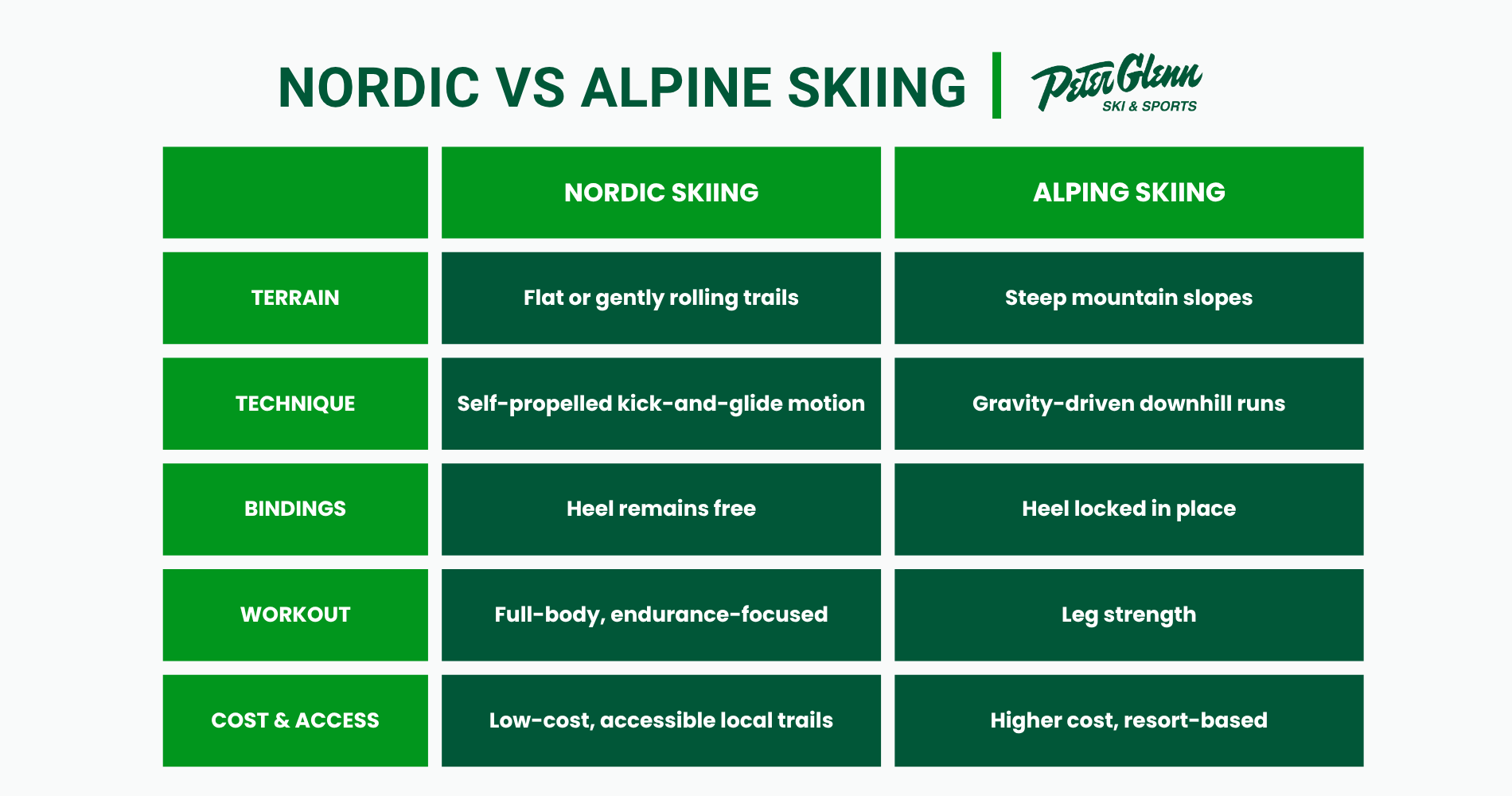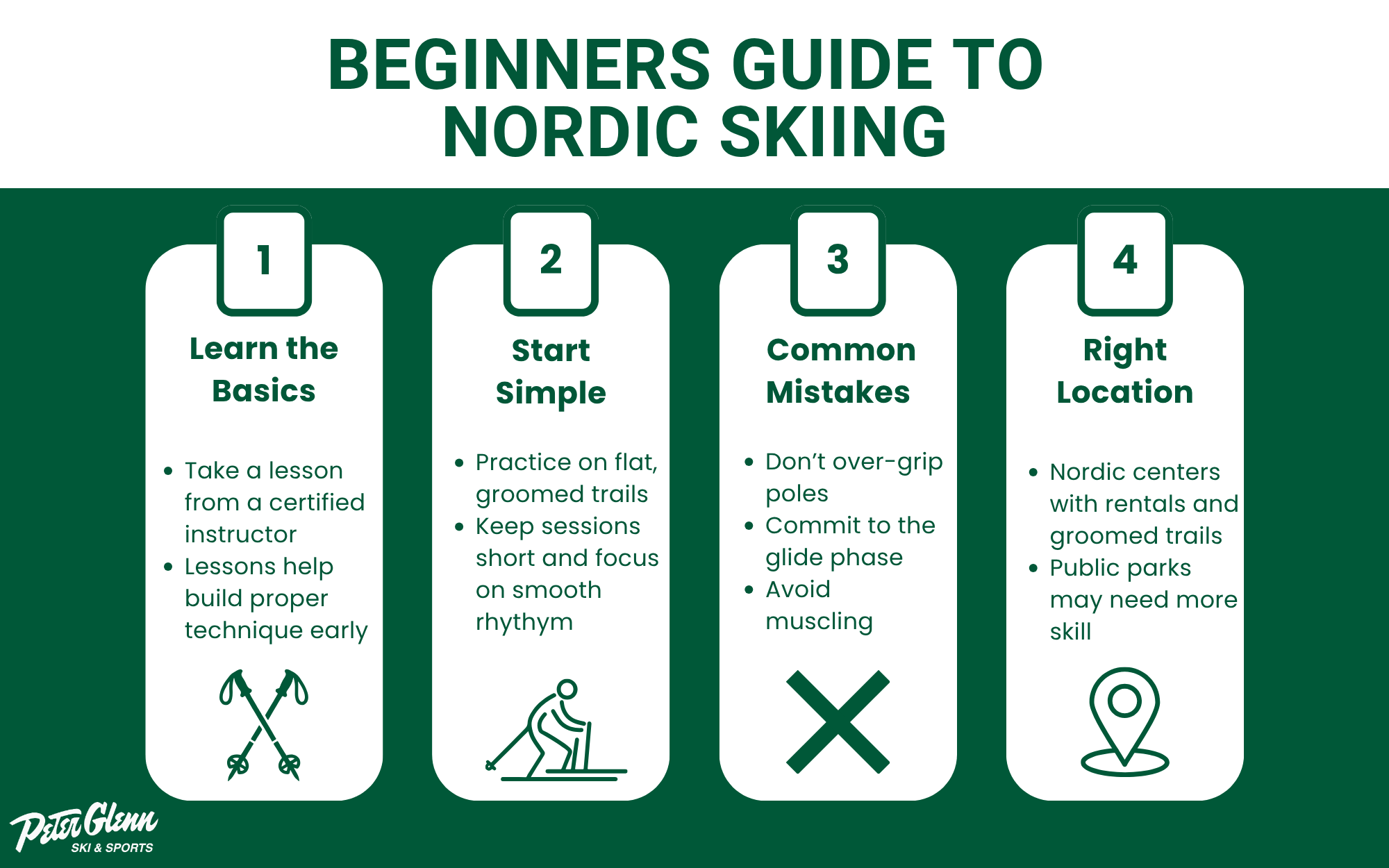What is Nordic Skiing? A Complete Guide for Beginners
Posted by Peter Glenn Staff on Oct 16th 2025
Table of Contents
The Short Answer: Nordic skiing, also known as cross-country skiing, is a winter sport where skiers use their own power to glide across snow-covered terrain with the help of long, narrow skis and poles. It includes both classic skiing and skate skiing techniques, providing a full-body workout while exploring winter trails.
If you’ve seen people gracefully gliding across flat or gently rolling snow-covered trails using long, narrow skis, they’re likely enjoying Nordic skiing. Unlike alpine skiing, which focuses on downhill runs, Nordic skiing emphasizes endurance, rhythm, and the peaceful exploration of winter landscapes at your own pace.
Key Differences Between Nordic and Alpine Skiing
Nordic and alpine skiing both offer unique winter experiences but differ in movement, terrain, and gear. Here’s a quick breakdown:

Nordic skiing emphasizes endurance and exploration, while alpine skiing delivers speed and excitement.
A Brief History of Nordic Skiing
Nordic skiing has its origins in Scandinavia, where it was used for transportation across snowy landscapes. Over time, it evolved into both a recreational activity and a competitive sport. Today, Nordic skiing is enjoyed by people of all ages, offering not only an excellent workout but also a way to connect with nature during the winter months.
Nordic Skiing Basics
Classic Skiing
Classic skiing is the most traditional form, where skiers use a diagonal stride technique. This method is often compared to walking or running on skis and is best suited for flat or gently inclined terrain. Classic skiing is performed on trails with parallel tracks, which help guide the skier’s movement.
Skate Skiing
Skate skiing is the faster, more athletic version of Nordic skiing. It mimics the movement of ice skating, where skiers push off the inside edge of one ski while gliding on the other in a V-shaped pattern. This technique requires smooth, groomed trails and provides a high-intensity workout that focuses on speed and efficiency.
Backcountry Skiing
Backcountry skiing, also known as ski touring or telemark skiing, takes you off the groomed trails and into untracked wilderness. Skiers use wider skis and specialized bindings to handle a variety of snow conditions and terrain. This style of skiing requires more advanced skills and a greater understanding of safety measures, especially when venturing into more rugged or remote areas.
Equipment Needed for Nordic Skiing
The right equipment can make a significant difference in your Nordic skiing experience.
- Skis: Classic skis are longer with a grip zone or wax pocket, while skate skis are shorter and smooth for faster gliding on groomed trails.
- Boots and Bindings: Classic boots are flexible and comfortable for walking motions, whereas skate boots are stiffer to provide lateral support. Bindings should match your boots and skiing style, so make sure to check compatibility.
- Poles: Poles should be the right length for your skiing technique. Classic ski poles should reach your armpits, while skate ski poles should come up to your chin or nose.
- Clothing: Dressing in layers is key. Base layers should wick moisture away from your skin, while mid-layers provide insulation, and outer layers protect from wind and light precipitation. Nordic skiing generates a lot of heat, so you’ll want to dress lighter than you would for other winter activities.
For beginners, renting equipment from a Nordic center offers a great way to test the sport before investing in your own gear.
Getting Started with Nordic Skiing

If you're new to Nordic skiing, learning the proper technique early on will make the sport more enjoyable and help prevent bad habits. While some people teach themselves, taking a lesson from a certified instructor can greatly speed up your learning process. Most Nordic centers offer group and private lessons, where experienced instructors can teach you the basics.
Beginner Technique Tips
When you start out, stick to flat surfaces and focus on short, manageable sessions. This will help you master the rhythm of the kick-and-glide technique without feeling overwhelmed. Some common mistakes include over-gripping the poles, not fully committing to the glide phase, and trying to muscle through the motions instead of finding a smooth, natural rhythm.
Where to Learn and Practice
For the best learning experience, look for Nordic centers with groomed trails and rental equipment. Many resorts and public parks also offer Nordic trails, but these may require more advanced skills due to less maintenance.
Safety Considerations and Trail Etiquette
Proper trail etiquette ensures a safe and enjoyable experience for everyone on the trails. Classic skiers should stay within the set tracks, while skate skiers should use the smooth area beside the tracks. Always announce yourself before passing other skiers.
Before heading out, check the snow conditions. Icy trails can make skiing more difficult, and fresh snow requires extra effort to break trails. Weather awareness is crucial, as conditions can change quickly, especially when venturing into the backcountry. Always carry extra layers, gloves, and a hat to stay comfortable and prepared.
Why Try Nordic Skiing?
Nordic skiing offers many benefits, both for fitness and mental well-being. It provides a full-body workout that strengthens the legs, core, and arms while improving cardiovascular health. Unlike many high-impact sports, Nordic skiing is low-impact on the joints, making it ideal for people looking for a joint-friendly workout.
- Cardiovascular Health: Improve heart health as you ski through beautiful winter landscapes.
- Strength and Endurance: Build core and leg strength while increasing stamina.
- Low-Impact: A perfect way to stay active in winter without straining your joints.
Beyond the fitness benefits, Nordic skiing allows you to connect with nature, enjoy the winter beauty around you, and experience the satisfaction of covering miles under your own power. Whether you're skiing on groomed trails or exploring the backcountry, the experience is both challenging and rewarding.
Ready to Get Started?
If you're ready to experience the thrill of Nordic skiing, visit Peter Glenn for expert guidance on selecting the right equipment, such as skis, boots, poles, and outerwear. Our knowledgeable staff will help you choose the gear that best fits your goals and skill level, ensuring you have a great experience on the trails.
Don’t let another winter pass you by. Grab your skis, find a trail, and get ready for your next adventure with top-quality ski clothing and gear from Peter Glenn.



